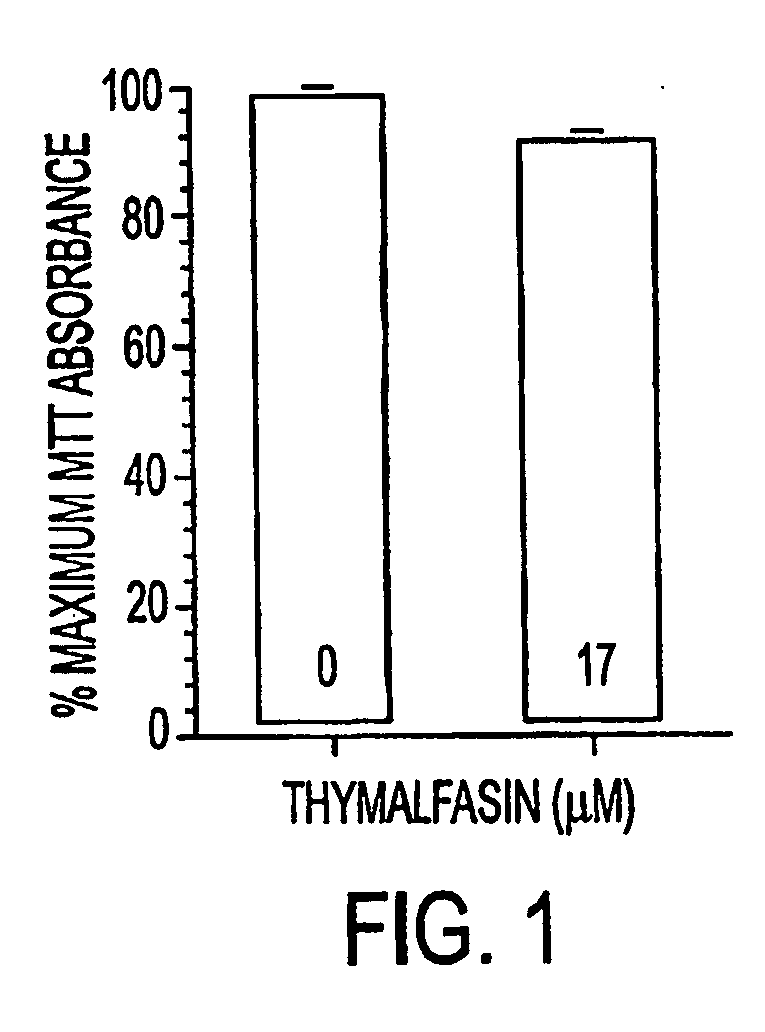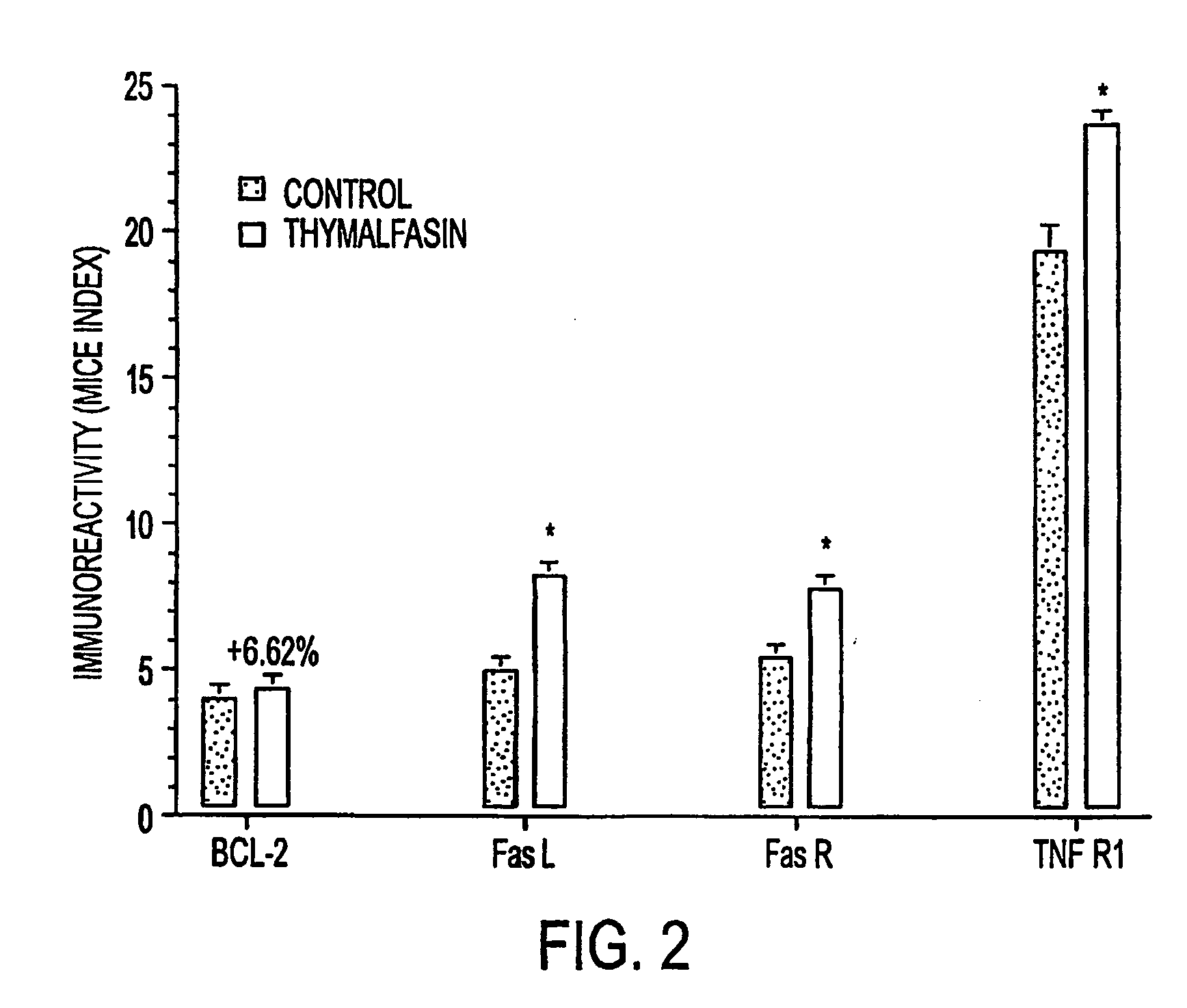Treatment of glioblastoma with thymosin-alpha 1
a technology of thymosin and glioblastoma, which is applied in the direction of peptides, drug compositions, peptides, etc., can solve the problems of not always supporting the effectiveness of these compounds as a single agent on brain tumors, and the immune response to neoplastic cells is mainly ineffective in completely eradicating residual neoplastic cells, so as to prolong the survival of patients with glioblastomas, reduce tumor burden, and increase the production of
- Summary
- Abstract
- Description
- Claims
- Application Information
AI Technical Summary
Benefits of technology
Problems solved by technology
Method used
Image
Examples
example 1
Thymosin-α1 Treatment of 9 L and 293 Tumor Cell Lines
[0025] Tumor cell lines: Rat 9 L glioblastoma cells and 293 human kidney cells were maintained in Dulbecco's Modified Eagle's Medium (DMEM) supplemented with 5% FCS, 2 mM L-glutamine, and 100 μM non-essential amino acids (Gibco-BRL, Grand Island, N.Y.). All cell lines were kept at 37° C. in a humidified atmosphere containing 5% CO2. The cell lines were obtained from the American Type Culture Collection and were certified as free of pathogens.
[0026] Thymosin alpha 1 treatment: For acute thymalfasin treatment, cells seeded in 96-well plates at a cell density of 20,000 cells / well were treated with 10−5 M thymalfasin for 24 hours. Cells treated chronically with thymalfasin were grown in flasks and treated every 24 hours with 10−5 M thymalfasin (added to fresh medium) for the duration of the treatment (3 days). In addition, for the determination of a dose-response curve to thymalfasin for 9 L cells, cells were treated with serially d...
example 2
Granzyme-Induced Apoptosis Studies
[0034] The MICE assay studies described above demonstrated thymalfasin-induced expression of TNF-R1, FasL and FasR in 9 L glioblastomas. In order to determine the differential susceptibility of 9 L glioblastoma cells treated (or not) with thymalfasin to cytotoxic T-lymphocyte (CTL) induced apoptosis, experimental assays were conducted in which 9 L cells were treated both acutely for 24 hours and chronically for 72 hours with thymalfasin, after which they were harvested, re-seeded into 96-well black plates (7.5×105 cells / 75 μl / well), and exposed to 20,000 units / ml Streptolysin O (SLO) plus 100 ng recombinant Granzyme B (reaction volume 100 μl) for 1 or 3 hours at 37° C. The SLO was used in place of perforin to permeabilize the cells, and recombinant Granzyme B was used to standardize the assay. Control studies included parallel reactions in which SLO, Granzyme B, or both were omitted. Viable cell density was measured using the ATPlite assay (Packard...
example 3
Effect of Thymalfasin on Cell Viability of Primary Neuronal Cell Cultures
[0036] Primary cortical neuron cultures were studied to enable selection of thymalfasin doses that would not be toxic to non-neoplastic brain cells. Cell viability and mitochondrial function were measured using the Crystal violet (CV) and MTT assays since previous studies showed that CV and MTT absorbances increase linearly with cell density from 1×104 to 5×105 cells per well (de la Monte, 2001 & 2000).
[0037] Primary neuronal cortical cells treated in 96-well plates with serial dilutions of thymalfasin (final concentrations ranging from 3.3×10−5 M to 1×10−9 M) showed no decrease in cell viability at the experimental doses used. The highest concentration of thymalfasin used (3.3×10−7M) did show a 30% decrease in viability as seen through MTT assay. However, this dose is higher than established experimental and clinical dosages.
PUM
| Property | Measurement | Unit |
|---|---|---|
| pH | aaaaa | aaaaa |
| pH | aaaaa | aaaaa |
| volume | aaaaa | aaaaa |
Abstract
Description
Claims
Application Information
 Login to View More
Login to View More - R&D
- Intellectual Property
- Life Sciences
- Materials
- Tech Scout
- Unparalleled Data Quality
- Higher Quality Content
- 60% Fewer Hallucinations
Browse by: Latest US Patents, China's latest patents, Technical Efficacy Thesaurus, Application Domain, Technology Topic, Popular Technical Reports.
© 2025 PatSnap. All rights reserved.Legal|Privacy policy|Modern Slavery Act Transparency Statement|Sitemap|About US| Contact US: help@patsnap.com



